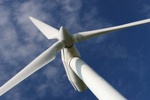Gust over Nantes railway station

Urban wind energy has reached centre stage. Despite the fact that there are still numerous obstacles to its development in France, it represents an extremely important area of research and improvement. And if it is not the role of the CSTB to participate in the development of the small wind turbine itself, it is its duty to possess all the necessary means to quantify the "energy yield" of this type of facility in order to meet the demands of projects owners and architects. The expertise developed by the CSTB teams is based on the following three factors: determination of the "quantity" (or potential) of wind for a given site at one or more heights, taking into account the environment (relief and roughness), calculation of the response of the small wind turbines to a given wind and, once both of these parameters being determined, assessment of the annual quantity of energy produced, referred to as annual energy production (AEP). "Climatology studies have been usual for several years in our department", emphasises Maeva Sabre of the CSTB. "Our accumulated knowledge enables us to calculate the wind energy potential for a given site, from data provided by the neighbouring meteorological stations." A mathematical model is used to ensure that these extrapolations also take account of the effects of existing buildings close to the future small wind turbine location. In addition to this numerical approach, the calibration of the performance of small wind turbines in a climatic wind tunnel enables us to measure their "response" – as also the energy produced – for different wind speeds and wind loads configurations.
Small wind turbines on the roof of the future Nantes railway station
A number of criteria must be taken into account when installing a small wind turbine in urban environment, whether it has a horizontal or vertical axis. The small wind turbine must be located on a building positioned perpendicularly to the prevailing winds, and preferably in the recirculation zones which induce accelerated wind speed. It is also possible to optimise the architecture of the building to improve its aerodynamic characteristics, and thus to create overspeed areas used to enhance the wind energy production.
The work done for the future Nantes railway station provides a perfect example of this skill. "At the request of the architect, AREP, we have worked on this building which will replace the two existing stations", said Christian Barré. "It will be situated above the tracks, which are directed in the prevailing winds' direction." What is so special about this new building? It's the roof. It is designed as a large parallelepiped of six metres thickness, inside which a number of funnels will be constructed. The minimum diameter at mid-width of the funnels will be no more than about two metres. The first simulations have showned that this arrangement makes it possible, by inducing a Venturi effect, to double the wind speed at the smallest diameter, and thus multiply the energy recovered by some ten small wind turbines located at the core of the roof, by a factor of eight. East winds, west winds: it will be possible to convert the lightest puff of wind over the new Nantes railway station into electricity.
